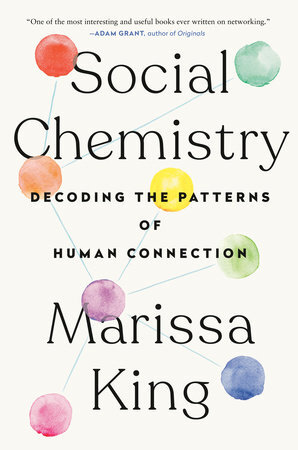Social Chemistry by Marissa King
/Social Chemistry: Decoding the Patterns of Human Connection
by Marissa King
Dutton, 2021
The topic of human relationships, despite its importance to all of us, or perhaps because of its importance, is one on which we seldom have an unbiased perspective. Awareness of the limits of first-hand experience, combined with the desire to overcome these limits, might push us toward the opposite kind of imbalance: a cold, detached, and hyper-objective vantage point of impartial observers. Marissa King's Social Chemistry: Decoding the Patterns of Human Connection attempts to strike a balance between the opposite poles, combining the subjective perspective with the objective perspective of a social scientist. The book takes us through a detailed examination of how we network, with an extensive discussion of some of our unexamined views about networking.
An idea that runs throughout the book is that most of us underestimate our agency over our relationships. As a result, we accept feeling disconnected or we remain in the wrong group. We may explain the situation using our personality traits, saying, "I'm an introvert. I'm just not good at networking." Or we may appeal to a negative self-assessment, saying, "I have nothing to offer." Similarly, we tend to underestimate how common our problems and worries are. King informs us that our worries about networking, our discomfort with taking up an active role, and our distaste for being seen as instrumentalizing social interactions are widely shared. Finding out that these worries are widely shared could be a first step toward feeling connected.
A substantial portion of the book is devoted to introducing three distinct styles of networking: expansion, convening, and brokerage. These should be treated as approximations and useful heuristics. Briefly, "expansionist" refers to someone who grows their networks by increasing the number of individual ties; a "convener", by contrast, strengthens the ties among others within the same network, creating team spirit; finally, a "broker" connects distinct networks. King praises the creative role of brokers, since what they do cannot be reduced to the act of introducing two strangers. The magic of network brokerage is in discovering the reason why different communities ought to be connected and why there is benefit in the connection.
We read at one point that the three constructs are not personality types, even though most of the text treats them in that way. Thinking of expansionists, conveners, and brokers as types of people would come at a price. We would end up explaining behavior based on what is inside the person ("Joe is a broker and, therefore, he is going to behave like a broker."), rather than tracing the development of the person and the ongoing interaction with the environment. Moreover, seeing networking styles as types of people creates the illusion that we understand someone because we have assigned a label to them ("Joe is acting like that, because he is broker.") This criticism is widely applicable in the social sciences, where what is being studied is replaced with the construct or model that is meant to represent (not replace) the target of study.
While the inclusion of a large number of studies in the book provides a rich view into the relevant research, the research is treated rather uncritically. Critical readers will likely notice the occasional thingification of technical terms and the frequent placing of the burden of explanation on agents rather than the on-going agent-environment interaction. For instance, when explaining networking success in terms of likability of the person, we should not think of likability as a one-directional force that emanates from the person out into the environment. Rather than thinking about people who differ in likability, we should probably think about different person-environment relationships that could be selectively (and incompletely) described with reference to likability. The "likable" person is in an exchange with their social environment, being impacted as much as impacting the environment. The tacit assumption that people with different characteristics inhabit the exact same environment is a bias that social scientists should challenge and not further reinforce.
Considering the research under a critical light might, in addition, lead us to wonder why certain research questions arise in the first place. In discussing trustworthiness, King appears surprised that researchers, despite decades of hard work, have not yet found any single cue, in body language or voice, that is consistently and reliably associated with trustworthiness. If we think about the intense evolutionary arms-race between, on one hand, the ability to deceive others, and on the other hand, the ability to detect deception, should we really be surprised to find that overt signs of trustworthiness or deception vary?
Despite its shortcomings, King's Social Chemistry can stimulate thought about human relationships and about the impact of relationships in other domains of life. At a time when social relationships have been brought into so much focus, the book offers a useful aid for thinking. The value of this type of work will ultimately come, not from replacing our subjective and involved perspectives with the detached view of social scientists, but from creating an on-going dialogue between the two.
—Davood Gozli is assistant professor of psychology at the University of Macau.
